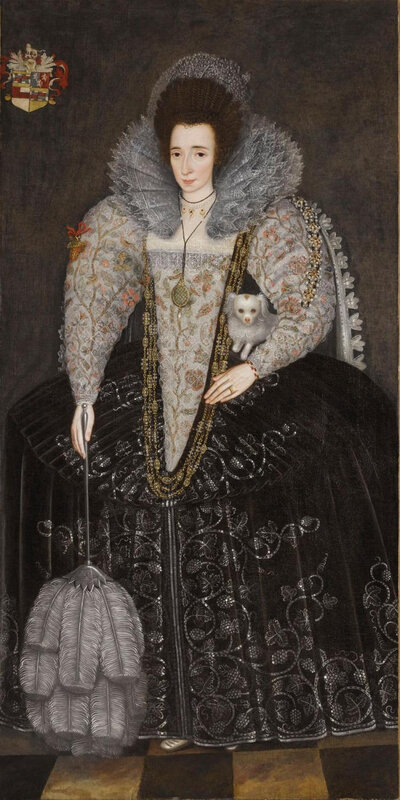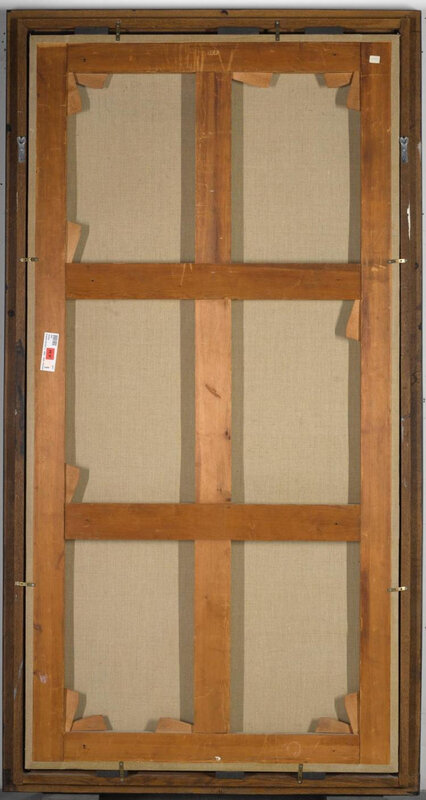English School, circa 1600-1603, Portrait of Anne Russell, Lady Herbert, later Countess of Worcester (d. 1639)
Lot 7. English School, circa 1600-1603, Portrait of Anne Russell, Lady Herbert, later Countess of Worcester (d. 1639), full-length, holding a dog and an ostrich-feather fan, charged with the arms of the sitter's husband Henry Somerset, Lord Herbert, later 5th Earl & 1st Marquess of Worcester (1577-1646), upper left; oil on canvas, 196.7 x 99.4 cm; 77 1/2 x 39 1/8 in. Estimate 80,000 — 120,000 GBP. Courtesy Sotheby's 2018.
Provenance: Sir William Barker, 4th Bt. (d. 1818), Kilcooley Abbey, Thurles, co. Tipperary;
Thence by descent within the Ponsonby Barker family at Kilcooley Abbey;
With The Weiss Gallery, London, 2004;
Private collection, London.
Literature: P. Somerville-Large, The Irish Country House: a social history, London 1995, reproduced plate 17b, hanging in the Gallereid Hall, Kilcooley Abbey, Thurles, co. Tipperary;
The Weiss Gallery, Icons of Splendour: Early Portraiture 1530-1700, London 2004, unpaginated, cat. no. 7, reproduced in colour;
The Weiss Gallery, The Weiss Gallery: 25 Years, London 2010, p. 111, cat. no. 99, reproduced in colour;
The Weiss Gallery, Courting Favour: From Elizabeth I to James I. Tudor & Jacobean court portraits 1560-1625, digital catalogue, published 26 June 2017, pp. 45-46, cat. no. 11, reproduced in colour p. 44.
Note: Anne Russell was the younger daughter of Lord John Russell (d. 1584) and Elizabeth Cooke (circa 1528-1609). She went to court as one of Queen Elizabeth I's last maids of honour in 1594, and on 16 June 1600 the Queen herself honoured Anne and Henry Somerset, Lord Herbert, later 5th Earl & 1st Marquess of Worcester (1577-1646), by attending their marriage, one of the last dynastic unions of Tudor England. A contemporary account, written by Rowland Whyte, records that 'The Feast wilbe in Blackfriars, my Lady Russell making exceeding Preparacions for yt [sic.].'1 George Vertue suggested that the large painting attributed to Robert Peake the Elder, now known as A Procession of Elizabeth I, depicts the Queen's very procession to Blackfriars for the wedding, with Lord Herbert and Anne identified as the figures in white, bearing the Queen's litter and following in her retinue respectively (though Roy Strong later dismissed this idea).2
This portrait represents some of the most extravagant court fashion worn during the final years of Elizabeth I's reign. Anne is portrayed in the costume associated with Elizabeth's maids of honour, such as the head-dress composed of silver wire and pearls, also depicted in likenesses of Catherine Killigrew (Ipswich Museum and Art Gallery) and Lady Elizabeth Southwell (Cowdray Park), for example. Her stomacher and leg-of-mutton sleeves are embroidered with intricate, colourful flowers, fruit, birds and insects, all overlaid with silk gauze, while the silver motif sewn into her black skirt would appear to represent a grapevine, or perhaps hops. Elizabeth is known to have gifted clothes from her vast wardrobe (by the time she died her gowns numbered over 2,000) to those closest to her, and it is just possible that this dress correlates with one recorded in an inventory of 1600: 'Item one loose gown of blacke silke and silver stitched cloth garnished with hopes of silver...'3
This portrait must have been painted after Anne and Henry Somerset married in the summer of 1600, as her wedding band is prominently displayed on her left hand. In addition to this, she wears a triple chain necklace of gold and pearls, a large locket on a jet necklace, bejewelled with diamonds and most probably containing a miniature of her new husband, as well as fine enamelled hearts at her neck, also indicating her recent marriage, with star and moon shapes with rubies suspended from the same string of pearls, typical of English jewellery in the first decades of the 17th century. The rich and deliberately-placed spinel- or ruby-encrusted pendant tied to her shoulder with red ribbon, representing either an acorn or a bunch of grapes (as in the skirt), must have been a specific and significant, but as yet untraced, jewel. The large, fashionable ostrich-feather fan complements these other rich accoutrements to express Anne's noble status and position of favour. The little dog tucked under her arm, balancing on her farthingale skirt, represents not only another expensive accessory, but also Anne's virtue of conjugal fidelity.
We are grateful to Diana Scarisbrick for her help in the cataloguing of this lot.
1. A. Collins, Letters and Memorials of state, London 1746, vol. II, p. 195.
2. Oil on canvas, 132 x 190.5 cm.; Wingfield-Digby collection, Sherborne Castle, Dorset; see R. Strong, Portraits of Queen Elizabeth I, Oxford 1963, pp. 86-86, cat. no. 101, reproduced plate XIX.
3. Folio f.35v, no. 87, in The Stowe Inventory, MS.557; quoted in J. Arnold, Queen Elizabeth's wardrobe unlock'd, Leeds 1988, p. 280.
Sotheby's. Old Master Paintings, London, 02 may 2018, 10:30 AM

/https%3A%2F%2Fprofilepics.canalblog.com%2Fprofilepics%2F1%2F0%2F100183.jpg)
/https%3A%2F%2Fstorage.canalblog.com%2F03%2F02%2F119589%2F96711876_o.jpg)
/https%3A%2F%2Fstorage.canalblog.com%2F11%2F31%2F119589%2F94773502_o.jpg)
/https%3A%2F%2Fstorage.canalblog.com%2F20%2F83%2F119589%2F94772815_o.jpg)
/https%3A%2F%2Fstorage.canalblog.com%2F26%2F72%2F119589%2F75604929_o.jpg)
/https%3A%2F%2Fstorage.canalblog.com%2F59%2F60%2F119589%2F26458628_o.jpg)





/http%3A%2F%2Fstorage.canalblog.com%2F97%2F97%2F119589%2F110835611_o.jpg)
/http%3A%2F%2Fstorage.canalblog.com%2F82%2F45%2F119589%2F76158763_o.jpg)
/image%2F1371349%2F20240506%2Fob_75d035_telechargement-14.jpg)
/image%2F1371349%2F20240506%2Fob_9d21db_telechargement-10.jpg)